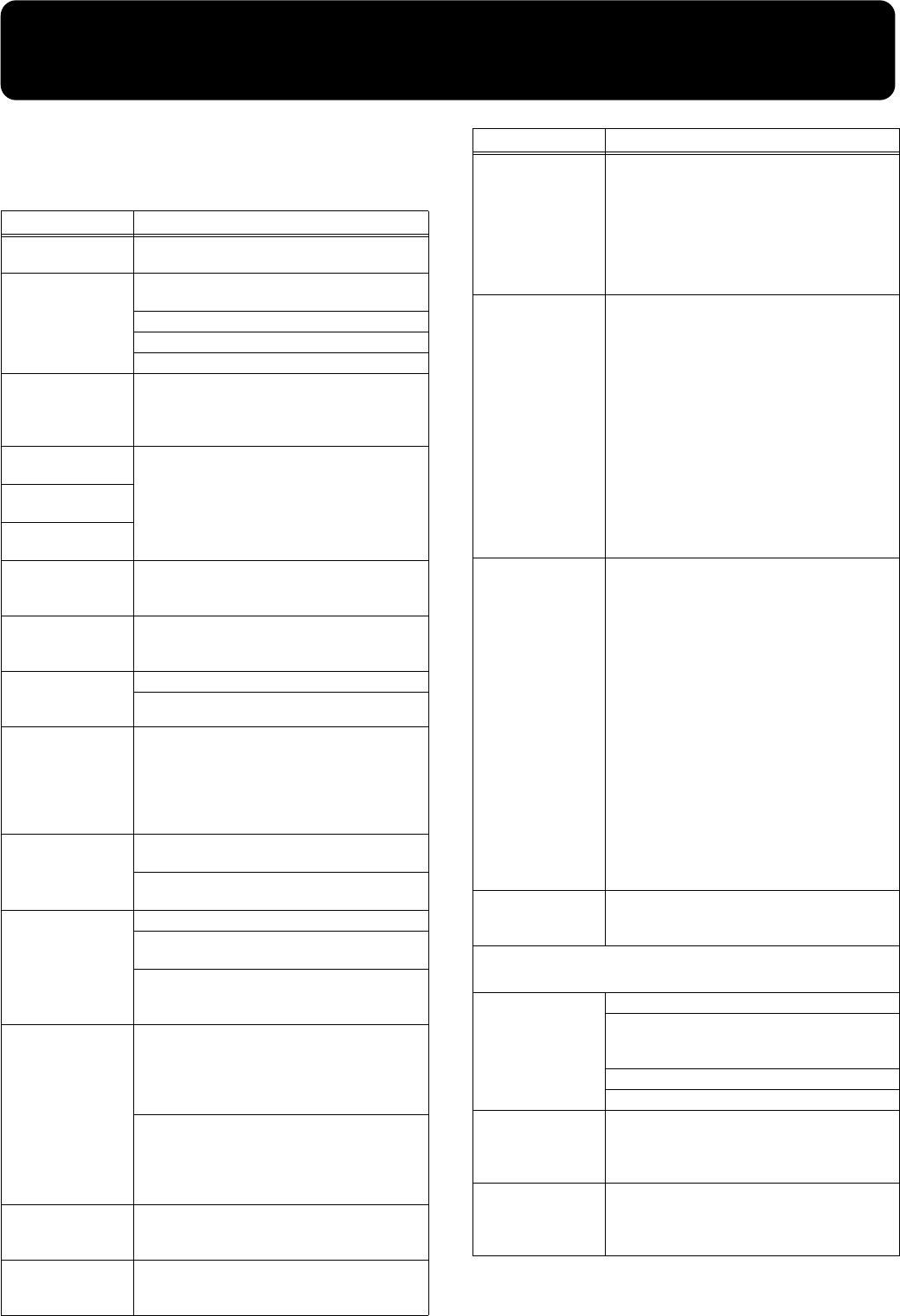
33
Troubleshooting
If you are encountering problems with the unit, please read
the section below before assuming that there is a
malfunction.
Case
Cause/Remedy
The piano cannot be
switched on
Is the AC adaptor properly connected? (p. 10)
No sound is produced
Is the [Volume] knob set to the minimum position?
(p. 12)
Are the headphones connected? (p. 12)
Is Local On/Off set to “Off”? (p. 31)
Is the speaker cable properly connected? (p. 6)
Only One Tone Plays
in Dual Play
Depending on the setting for volume balance, and the
particular selection of tones you make, certain tones
may be difficult to hear when layered. Try adjusting
volume balance (p. 28).
Internal songs do not
play
Is Panel Lock on? (p. 26)
Buttons do not func-
tion
Keyboard sound does
not change
Two sounds are pro-
duced when the key-
board is played
Is the keyboard in Dual Play mode? (p. 16)
The tone has changed
in the Dual Play
If you use Dual Play with a Tone button for which
tone number 3 or 4 is selected, tone number 1 will be
selected for that Tone button (p. 15).
The pitch of the key-
board sounds incor-
rect
Is the Master Tuning setting correct? (p. 27)
Is the Key Transpose setting correct? (p. 27)
Song doesn’t play
back/ Only the sound
of a particular part in a
song does not play
Are the indicator for the [1] or [2] button extin-
guished, when you press the [Track] button? (p. 14)
If the button indicator is out, the music on that track
is not heard.
Hold down the [Track] button and press the [1] or [2]
button, illuminating its indicator.
Rhythm doesn’t sound
It is not possible to sound the rhythm while an inter-
nal song is playing back or recording.
A performance that was recorded using metronome
cannot be played back with the rhythm.
Metronome does not
sound
Is Panel Lock on? (p. 26)
A performance that was recorded using rhythm can-
not be played back with the metronome.
If Rhythm is selected, the metronome will not sound
even if you press the button. Please re-select the beat
(time signature) of the metronome (p. 19).
Tempo of recorded
song or metronome is
off
If you select an internal song in which the tempo
changes during the song, and then record, the tempo
will change in the same way for the performances.
The tempo of the metronome will also change in the
same way.
If you record additional material without erasing the
previously recorded song, the song will be recorded
at the first-recorded tempo. Please erase the previ-
ously recorded song before you re-record
(p. 25).
The recorded perfor-
mance has disap-
peared
Any performance that has been recorded is deleted
when the power to the F-100 is turned off. A perfor-
mance cannot be restored once it’s been deleted.
Sound is distorted
Raising the volume too high may distort the sound.
Adjust the volume level with the [Volume] knob
(p. 12).
In the upper range, the
sound changes
abruptly beyond a cer-
tain key
On an acoustic piano, notes in the upper one and a
half octaves of the keyboard continue to sound until
they decay naturally, regardless of the damper pedal.
There is a difference in the timbre as well. Roland pi-
anos faithfully simulate such characteristics of the
acoustic piano. On the F-100, the range that is unaf-
fected by the damper pedal will change depending
on the Key Transpose setting.
A High-pitched whine
is produced
When listening through headphones:
Some of the more flamboyant and effervescent pi-
ano tones feature an ample high-end component,
which may make the sound appear to have metal-
lic reverberation
added. Since this reverberation becomes particu-
larly audible when supplemented by heavy re-
verb, you may be able to diminish the problem by
reducing the amount of reverb applied to the
sound.
When listening through speakers:
Here, a different cause (such as resonance pro-
duced by the F-100) would be suspect. Consult
your Roland dealer or nearest
Roland Service Center.
Bass notes sound
wrong/buzzing or vi-
bration occurs
If you can’t hear the problem in the headphones:
When playing at high volumes, resonance may
occur in the piano itself or in objects near the pi-
ano. At times, other objects in the room, such as
fluorescent lights or glass doors, could start vi-
brating. Such phenomenon becomes more preva-
lent when sounding the lower frequencies at high
volume. To minimize such unwanted resonance,
please observe the following:
- Locate the instrument so it is 10-15 cm away
from walls.
- Reduce the volume.
- Increase the distance from the object that is res-
onating.
- Place the keyboard lid farther away from the pi-
ano.
If you can hear the problem in the headphones:
The problem may be for a different reason. Please
contact your dealer.
The pedals are not
functioning, or function
intermittently
Are the pedals connected properly? (p. 10)
When the F-100 is connected to an external
device
No sound is produced
Is the power to all equipment turned on?
Are the connections between F-100 and the MIDI se-
quencer or the other external devices correct? (p. 29,
p. 30)
Is the MIDI channel setting correct? (p. 32)
Is the Omni On/Off setting correct? (p. 31)
Strange sounds (or
two sounds) are pro-
duced when the
F-100 is played
With the sequencer’s “Thru” function on, the same
notes may be sounded twice. Set the F-100 to Local off
(p. 31).
The volume level of
the instrument con-
nected to the Input
jack is too low.
Could you be using a connection cable that contains
a resistor?
Use a connection cable that does not contain a resis-
tor.
Case
Cause/Remedy
F-100.e.book 33 ページ 2003年8月29日 金曜日 午前9時48分


















